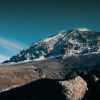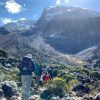Mount Kilimanjaro, found in Tanzania, is Africa’s tallest mountain and a famous trekking spot. Each year, many adventurers aim to reach its highest point, Uhuru Peak, which stands at 5,895 meters (19,341 feet) above sea level. While the journey to the high camp takes days, the final climb usually happens at night. But why is that?
Better Trail Conditions
Climbing mountains usually starts at night, and Kilimanjaro is no different. The main reason is the cooler temperatures at night. Cold weather keeps things in place, reducing the risk of avalanches or falling rocks. It also makes the ground more stable, which is essential when walking on snow and ice with crampons. During the day, the sun can melt the snow and ice, making the path slippery and dangerous. On Kilimanjaro, the terrain is made of volcanic rock, sand, and scree, which is loose during the day but frozen at night, making it easier to climb.
Time Management
The journey to the summit and back, along with the descent to the final camp, is long and requires ample time. The trek to the summit from high camp takes 6-8 hours, and the descent to the last camp takes 4-6 hours. This totals 10-14 hours on the trail, not including breaks. Starting the climb in the middle of the night ensures there’s enough time to reach the summit and return to camp before darkness falls. This approach also provides more daylight in case of emergencies, reducing the risk of slips and falls when descending in the dark.
Witnessing The Kilimanjaro Sunrise
Guides aim to time the climb so that trekkers reach the summit just after sunrise. This moment is truly magical, as the first rays of the sun illuminate the sky and the landscape, creating a breathtaking view. It’s an unforgettable experience that many climbers cherish. The early morning visibility on Mount Kilimanjaro is usually excellent, offering a clear and expansive view.
Why Descend So Far After Summiting?
Some wonder why climbers don’t simply return to high camp after reaching the summit to complete the hike during daylight hours. There are three important reasons for this:
Recovery At Lower Altitude
High camps on Kilimanjaro are at an elevation of around 15,000 feet, where sleeping and recovering is challenging. Staying another night at this altitude could worsen a person’s condition due to sleep deprivation, fatigue, dehydration, or altitude sickness. Descending after summiting allows climbers to recover in a more oxygen-rich environment at 10,000 feet, aiding in their well-being.
Lack Of Water Sources On Upper Slopes
Water sources on Kilimanjaro are primarily located on the lower and middle slopes, with none on the upper slopes. All water used at high camp must be carried from lower elevations. Staying an extra night would require more water and additional manpower for water collection.
Limited Space At Campsites
Kilimanjaro has multiple routes that converge at a few campsites, causing limited space. After summiting, climbers must vacate the high camp to make room for those who are about to attempt their summit.
In Conclusion
Climbing Kilimanjaro at night offers several benefits, including safer trail conditions, more time, and stunning views at sunrise. While a night ascent may seem challenging due to darkness, cold, and wind, the advantages outweigh the drawbacks. Rest assured that it’s done with your best interests in mind.




